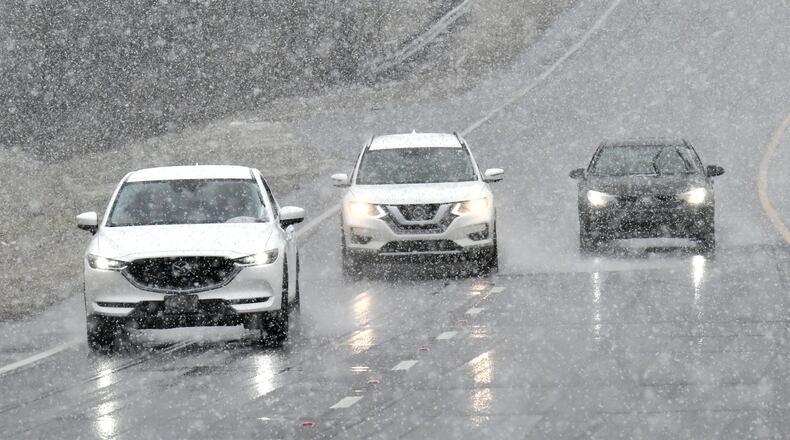Shoulders tensed. Stomachs churned. French toast ingredient-procurers invaded grocery stores. The National Weather Service deployed a winter storm warning for the mountains and then an advisory for a large swath of the Atlanta metro.
Last Sunday was a hunker down moment.
While heavy winds put pressure on power crews and the few travelers on MLK holiday weekend, the impact of ice and snow was larger in the mountains. Atlanta got snow — just enough to be interesting and alter plans. But the worst of Mother Nature’s icy fury spared our region once again.
Atlanta was set to see its worst winter weather event since the legendary January 2014 Snowicepocalypsegeddon. We talked here a couple of weeks ago about what happened on I-95 and the emergency items to keep in a car, in case one gets stranded. Hundreds sat for hours on a heavily snowed-in I-95 in North Virginia just after New Year’s Day.
Multiple inches of snow were a possibility closer to town, with freezing rain and sleet forecast as very likely. 95.5 WSB meteorologist Christina Edwards was most worried about that icy buildup taking down trees and wires and freezing on roads.
As Georgia Power and local EMCs staffed up, GDOT began Friday deploying road crews to drop brine on the thousands of miles of North Georgia interstate and highway lanes. Brine decreases the freezing point for precipitation when it hits the roads.
“Hats off to the DOT for spreading the brine solution on the roads. The pre-treatment certainly kept those who did venture out moving on the major roadways,” WSB Triple Team Traffic’s Smilin’ Mark McKay said. McKay and Alex Williams worked the first half of Sunday on radio and TV as the first round of weather arrived. I worked after lunch in the WSB 24-Hour Traffic Center with David Hubbard and George Clark as snow increased in-town.
One concern with the brine was similar to what Virginia crews dealt with early this month: Heavy rain before the snow could potentially wash away the treatment. If the precipitation changed over before trucks could spill more brine, there would be more freezing potential.
As the week progressed, the forecast for that changeover pushed from Saturday into Sunday and from early morning to early afternoon. The early morning hours that Sunday, however, brought traffic challenges before wintry mixes arrived.
Rain overnight Saturday into Sunday and then high wind gusts downed trees and wires all over town, prompting a few dozen road closures. Those winds howled through Sunday and Monday causing more isolated damage reports. Statewide power outages peaked Sunday morning at just over 100,000 customers, with Hall County seeing the biggest metro Atlanta impact.
“As predicted, the northeast corridor was hammered. At one point, I was told by a Hall County 911 dispatcher that the secondary roads were impassable and one deputy had recommended shutting down I-985,” McKay said.
As the rain changed to snow, it fell heaviest on the northern reaches of I-85 and I-985 and some stretches did get slick. But GDOT kept treating them and keeping them passable. I-985 did get dicey at one point and saw several wrecks late Sunday morning.
Despite scattered reports of ice and snow creating tricky spots on Atlanta roads, including some icy spots on frigid Monday and Tuesday mornings, this winter weather scare was not a big traffic event. McKay: “It was a Winter Wonderland flying in the WSB Skycopter on Monday morning along the I-85 and I-985 corridor north of the Mall of Georgia. And bridges and overpasses were still tricky as ice remained.”
Police shut down the Old Peachtree bridge over I-85 that Monday to treat ice, but it opened by mid-morning.
The heavy rain on Sunday was a bigger cause for traffic pain than any sleet or snow was. Multiple wrecks happened in the spot they always do in that weather: I-20/westbound just east of Candler Road (Exit 65) in DeKalb. There were some other wrecks on Sunday on wet ramps and a few other scattered problems.
Atlantans largely took this winter weather threat seriously and kept the roads clear both to be treated and to keep the crash counts low. Sunday, January 16th, was a great rainy day to stay inside and watch the liquid morph into a pretty snowfall.
But our region also got super lucky. Edwards, whose meteorological stamina got put to the test that entire weekend, with the demands of a changing forecast and all the needs of extra live programming on Sunday, dealt with a tricky system. This storm’s potential was dangerous for the state, but its complexity kept her on her toes. She recapped the event in a blog post, saying that this storm was a “Rubik’s Cube”, with temperatures widely varying.
The air behind the rain just never got cold enough. Edwards said that by Sunday evening, the cold air from the Nashville area that was supposed to facilitate the icy changeover was actually closer to 40 degrees.
Meanwhile, the Traffic Team and I monitored pavement temperatures and saw some areas flirt with the freezing mark, but they never stayed consistently cold enough to freeze. Phew.
Naysayers would mark this as another “overhyped Atlanta weather event.” Not so. All signs pointed to this weather system being dangerous and potentially destructive. In some places it was.
Clermont, in Hall County, got six inches of snow. Hall County and Gainesville City schools canceled Tuesday classes, because the county still had power outages.
North Georgia had luck and preparation on its side. Winter weather hit on a Sunday, not a weekday. Monday was MLK Day, meaning fewer people had to travel. And the cold air and water never mixed enough to create more snow or freezing rain.
Given the potential for worse weather, churches canceled in-person services, people limited travel, and road and power crews deployed early.
When our area hears the distant warning roar of Old Man Winter again, Atlantans need to act with the same caution and also keep their fingers crossed that arctic air and moisture don’t rekindle their romance in the North Georgia mountains.
Doug Turnbull, the PM drive Skycopter anchor for Triple Team Traffic on 95.5 WSB, is the Gridlock Guy. He also hosts a traffic podcast with Smilin’ Mark McKay on wsbradio.com. Contact him at Doug.Turnbull@cmg.com.
About the Author
The Latest
Featured



